
Whether we are talking about leaves from your gracious English walnut, or black walnut leaves, gardeners have a tendency to tense up. “Not in my garden!”, they say.
There are fears about nothing growing under the trees, about the leaves killing their garden when used as mulch, or that the leaves are poisonous themselves. Things are always scarier when you are in the dark.
Despite all that, people love to eat walnuts.
In cakes, cookies, pie crusts and lovingly tossed into homemade granola bars.
On top of that, walnuts are easy to harvest, dry and store. In our personal experience, the first two years after harvest are best for fresh eating. In the third year, walnuts are still great for baking and cooking with.
Then they go rancid in the 4th year of storage. Eat them before they lose their nutty flavor and delicious, fresh fat.
After your wintery-walnut food cravings are set aside, you are back to the question of “What’s the problem with growing a walnut tree in my backyard?”
What’s So Bad About Walnut Trees?
It is common knowledge that black walnuts and other members of the walnut family (Juglandaceae) produce an organic compound called juglone. Nature wouldn’t have it any other way. Even still, it seems that it may be a myth that walnuts produce juglone.
As hard as we try, we still don’t have all the answers.
What is for sure, is that walnuts do have allelopathic qualities. Meaning that they produce certain chemicals that make life more difficult for other plants growing underneath, or nearby.
It would be wrong to say that walnut trees by themselves are killers.
In fact, walnut trees can very easily be integrated into your orchard, forest garden or landscaped backyard.
The juglone that each walnut tree produces through roots, leaves, buds and nuts, is not so severe to interrupt the growth of some common garden veggies either.
Vegetables resistant to juglone include:
- beans
- beets
- carrots
- corn
- melons
- onions
- parsnips
- squashes
When talking about companion planting, walnuts can also enjoy the company of several wildflowers and herbs. Many of which may feature in your hedgerow.
To find out more about what you can plant near walnuts, this article from Penn State is extermely helpful: Landscaping and Gardening Around Walnuts and Other Juglone Producing Plants
Set your worries about walnut leaves aside for a moment. Let’s examine what you can do with them, should you already have walnut trees on your property.
What’s So Good About Walnut Leaves?
You might be surprised to find out that you haven’t been using walnut leaves to their full potential.
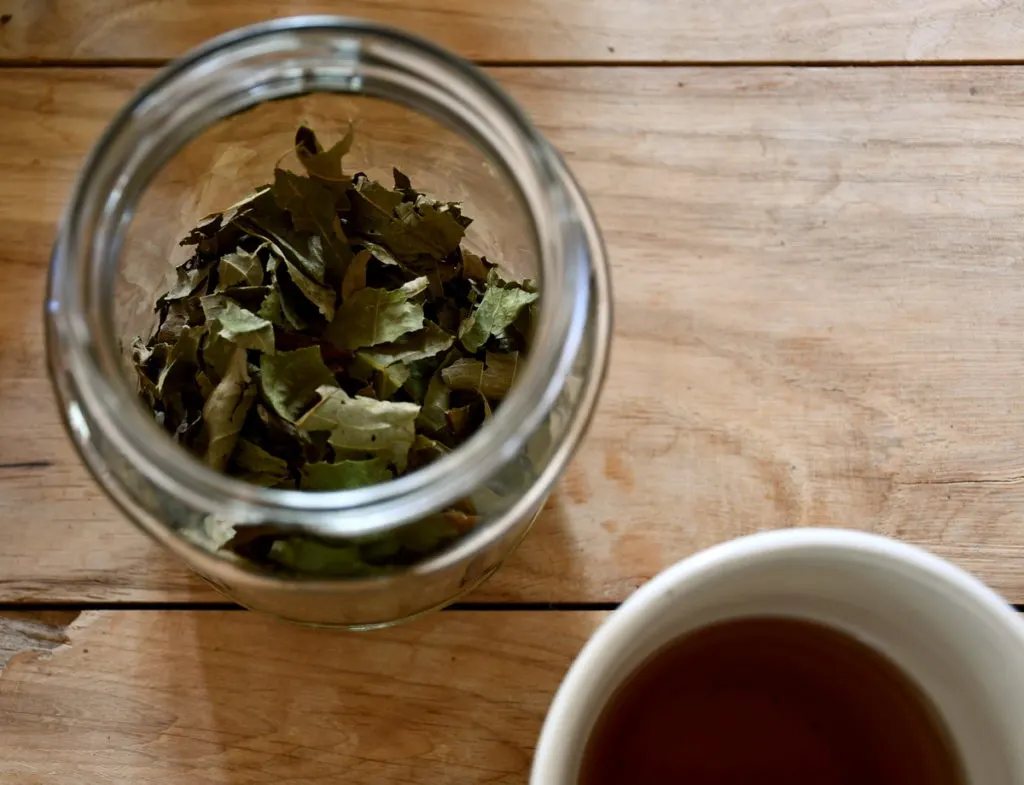
Walnut leaves can be used in teas, tinctures, hair rinses and yes, they can even be composted.
All things considered, you’ll often want to be using the leaves of English walnuts (Juglans regia) rather than those of black walnuts (Juglans nigra) for most of the ways listed below. However, many times black walnut leaves can be used interchangeably with stronger results.
1. Walnut Leaf Tea
Walnut leaves are especially useful in natural healing because they have both anti-bacterial and anti-parasitic properties.
These benefits can be extracted by boiling the leaves in water, in the form of a tea or an infusion to rinse the hair and body.
Whereas the nuts of the English walnut promote a healthy gut, are a rich source of Omega-3s and promote a healthy brain function, the leaves do something a bit different.
Walnut leaf tea is used internally for treating:
- diabetes
- diarrhea
- hemorroids
- gout
- blood impurities
- perspiration
- anemia
- intestinal parasites
As an astringent and antiseptic it allows for healing throughout the entire body – yes, topically as well.
To make a delicious cup of black walnut tea…
Start with 2 tablespoons of dry walnut leaves per quart/liter of water.
I like to bring this to a boil, letting it simmer for about 5 minutes.
Remove from the heat and let it sit under a lid for about 10 minutes.
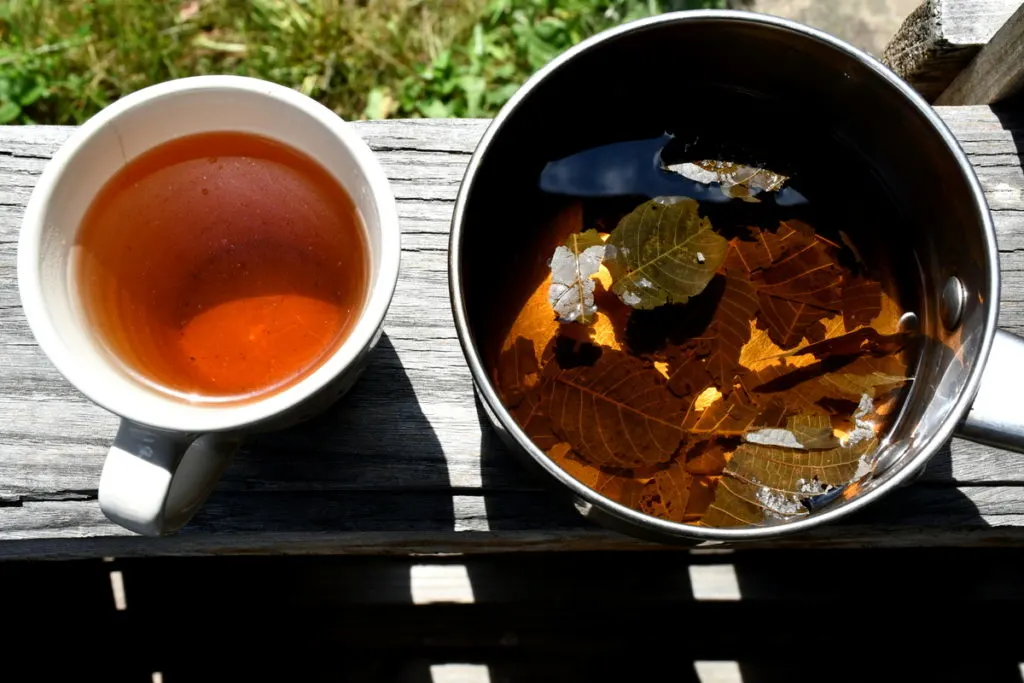
Strain and drink while it’s warm – or serve it cold with ice cubes. If you’ve never tried it before the flavor may be strange at first. Keep drinking (no more than 2 to 3 cups a day) and you’ll find that you do enjoy the flavor after all.
Walnut leaf makes for a pleasant herbal tea that can be sipped whenever you feel the need for it.
It is contraindicated if you are sensitive to tannins.
2. Walnut Leaf Tincture
We live in a time where food is abundant and digestive disorders are not uncommon. Somewhere there is a connection between the two.
Factor in the quality of food, organic vs. conventional, additives, preservatives, sweeteners, food colorings and perhaps some not-so-clean water; and you can be in for an unexpected surprise.
If the thought of intestinal worms gives you shivers, you aren’t alone. It happens more than one would like to think about, in animals and in humans too. You can eat all the raw garlic and pumpkin seeds you like, but an additional sip of walnut leaf tincture won’t hurt your gut either.
In fact, it will help it.
Not only with getting rid of parasites, but also helping you to recover faster from a common cold or the flu.
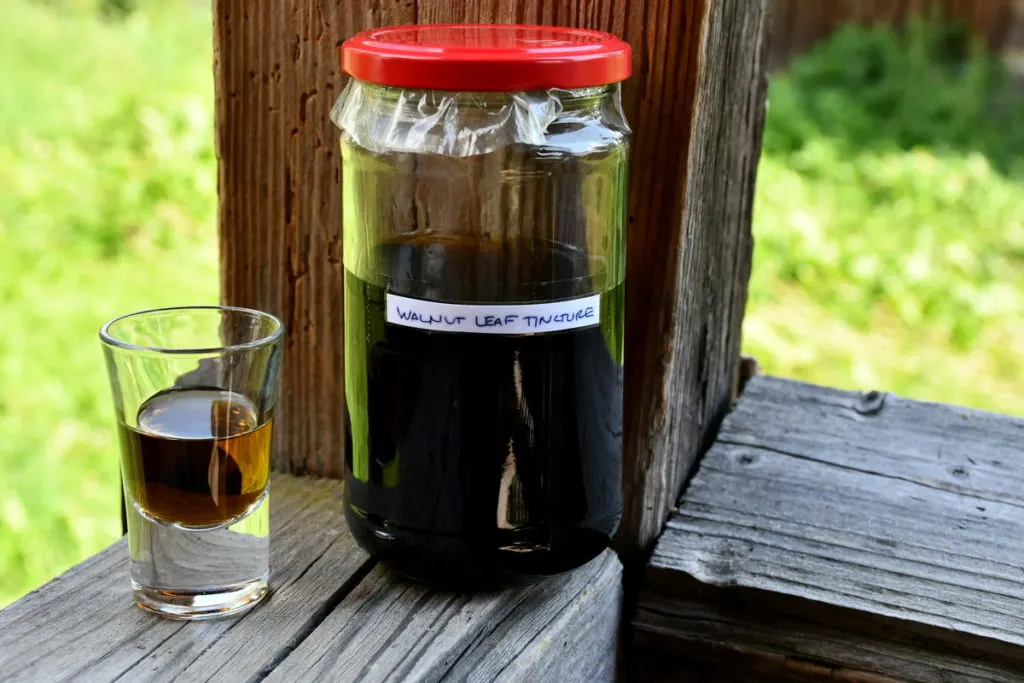
How to Make a Walnut Leaf Tincture
Collect and dry a bunch of walnut leaves, letting them hang for about a week.
Stuff them whole in a wide-mouth jar, add enough alcohol to cover and let it sit in a dark place for 4-6 weeks.
Strain the leaves and store the tincture in a dark, glass bottle. Use accordingly, and as needed. 15-20 drops a day would be sufficient for most people.
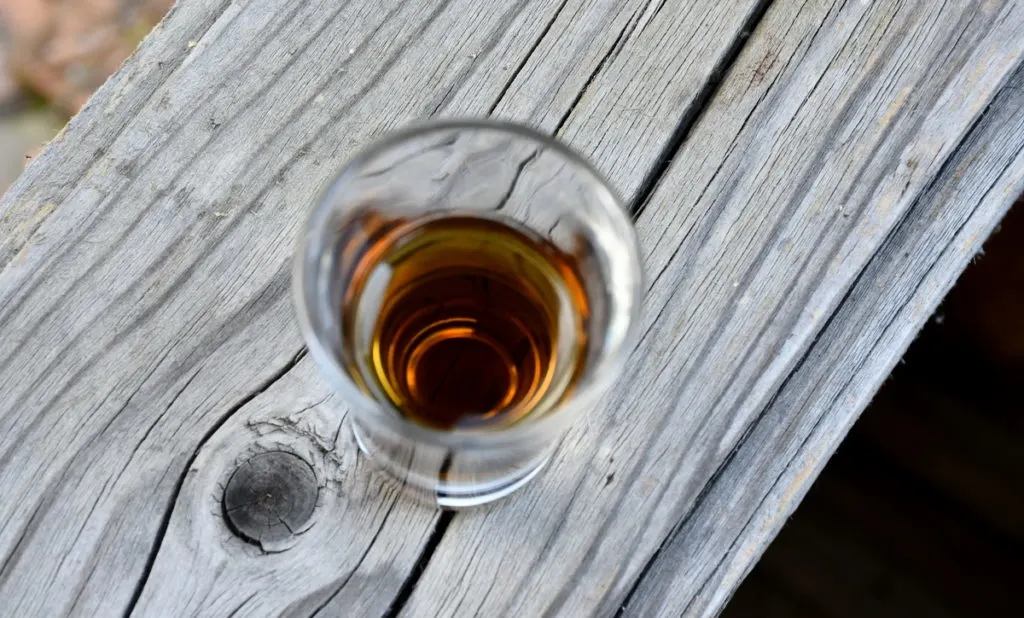
Not only is walnut leaf tincture good for cleansing your digestive tract, but it can also help your teeth and gums as well.
You can make a black walnut tincture using the hulls of English or black walnuts too.
Black Walnut Liquor
I know, it isn’t a tincture and it uses the green (unripe) black walnuts, so technically it doesn’t fit into a list about uses of walnut leaves. However, this particular recipe is worth mentioning because it is so unique.
Nocino is an Italian-style black walnut liquor that is similar to Unicum or Jägermeister in color, yet the flavor is beyond compare.
Best of all, if you are into foraging and concocting your own special alcoholic drinks (like limoncello), it ticks both boxes.
Jump to the Nocino recipe here.
3. Hair Rinse of Walnut Leaves
Preparations of walnut leaves have high quantities of astringent tannins which tighten the tissues of the skin.
This makes it valuable in treating certain skin conditions such as eczema, acne, psoriasis and dandruff.
It’s also said to provide relief from sunburn and excessive sweating of the hands and feet.
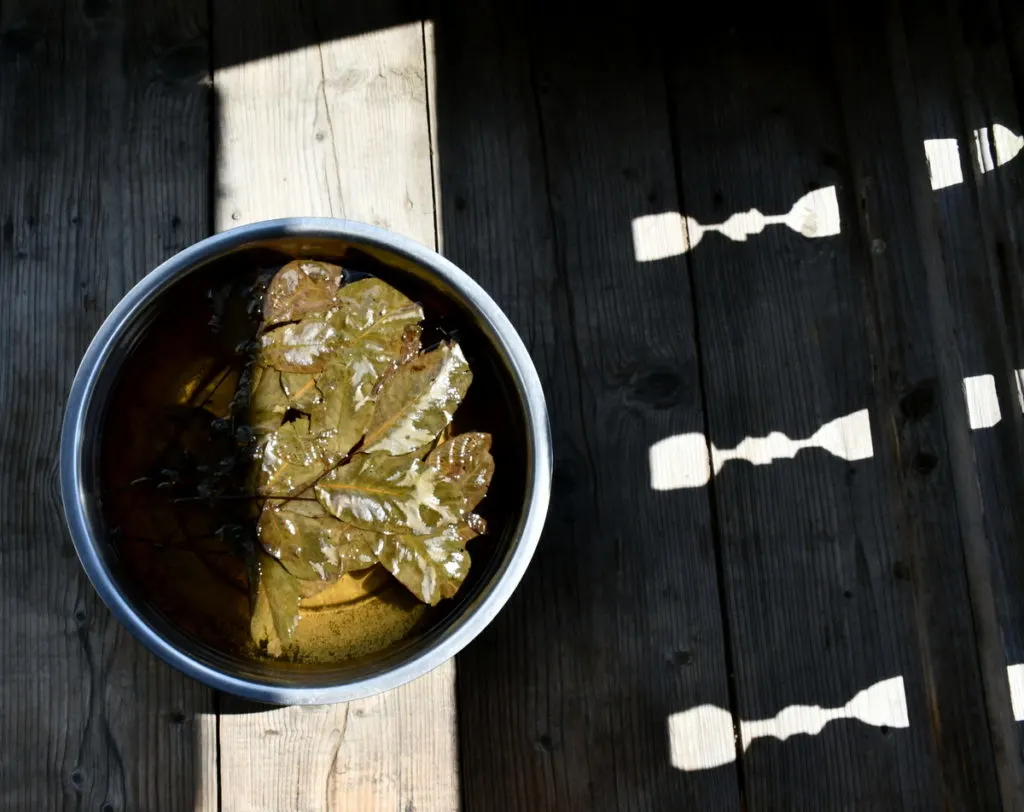
We often use herbal rinses for our hair, preferring walnut leaves above all for the way it smells and the way it tightens the scalp. It’s like a spa treatment for free in your own home.
Walnut leaves and hulls can also act as a temporary brown hair dye.
Similar to making tea, now fill a larger pot with even more fresh or dry leaves. Bring them to a boil and let them simmer for 10-15 minutes.
Let it come to a temperature that is skin-friendly and rinse your hair in a basin. If you wish to darken your hair, leave it on as long as possible. There is no need to rinse it off.
4. Walnut Leaf Dye
Just as you can dye your hair, you can also dye your clothes.
Over the years, I’ve found that walnut leaves make one of the most reliable brown dyes. Here, it is perfectly acceptable to use the leaves of black or English walnuts.
For a slightly different color, you can also try the green hulls, or the dry brown shells.
To make the darkest, most potent dye possible, harvest enough leaves to fill half of your dye pot. Top it off with water and bring to a boil, then lower to a simmer. Gently simmer over low heat for about an hour.
Let the dye sit two more full days longer, preferably outside.
After 48 hours, strain the leaves, bring to a simmer again and dip in your fabric or clothes. Let your garment sit in the dye bath for up to an hour, remove and rinse.
Don’t forget to wear gloves! Or your hands will be temporarily brown too.
This dye from either walnut leaves or hulls, can also be used to dye handwoven baskets.
5. Composting Walnut Leaves
In the realm of composting, everyone has an answer to everything, yet sometimes they are wrong, or misinformed. Or perhaps we make mistakes, because we aren’t open to new information.
Whatever the case may be, walnut leaves can in fact be composted, as the juglone breaks down when exposed to water, bacteria and air (that’s compost!). In as little as two to four weeks the toxicity of the leaves can be broken down.
If you are putting walnut wood chips on the compost, however, it will take about six months to break down the juglone to safe levels.
The length of time it takes to compost will also depend on your method of composting. So, err on the side of caution and let it sit a little bit longer, especially if you intend to put your compost in the vegetable garden.
6. Walnut Leaves as Mulch
Mulch? Are you crazy?
Well, maybe. We do have a no-dig garden after all. It’s an unconventional approach to growing food, especially since we rarely plant in lines.
Our method of mulching is to use multiple layers. We start in fall with excess leaves from the fruit trees (pears, apples, cherries). In spring we mulch with hay which grows aplenty here.
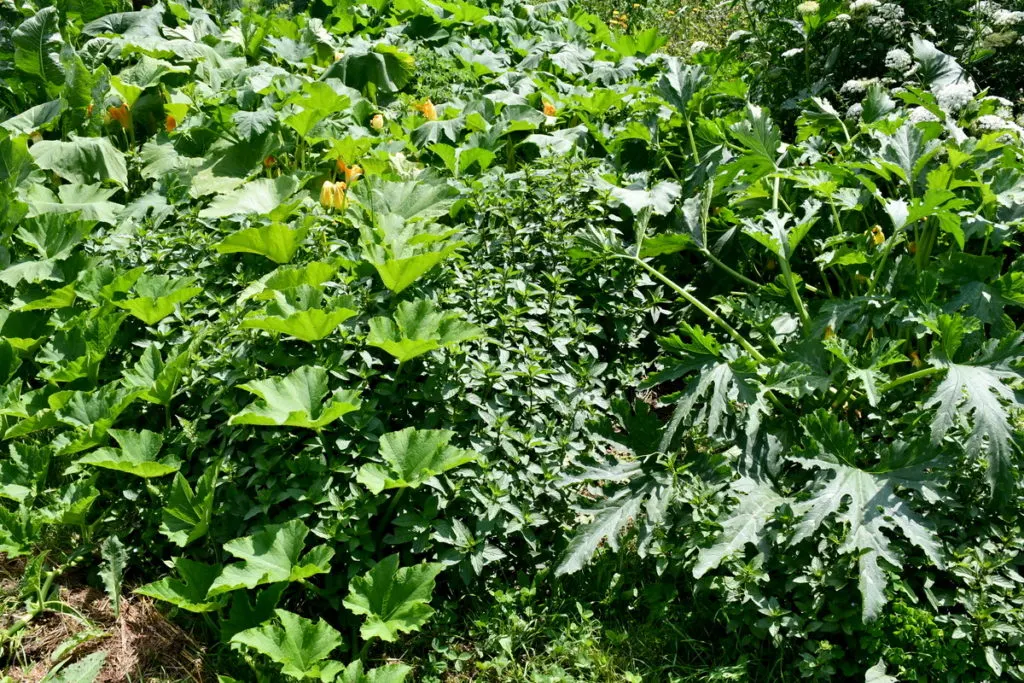
When the time arises, we also put fallen walnut leaves on the paths. They quickly break down and become part of the soil.
It isn’t advised to use walnut leaves as mulch right where you plant, but we’ve had no problems using a small amount on paths. Use them to cover the ground where you don’t want plants to grow.
When in doubt, go for the hot composting method, it works well every time.
Black Walnut Ink Made From Hulls
If you have walnut trees in your backyard or access to a stand nearby, you’re going to have much more than leaves.
One of our favorite things to make with the hulls is black walnut ink.
Make a large batch and use it for drawing, painting, lettering, journaling, writing poetry, whatever your heart desires.
Here’s a quick video and article about how to make your own black walnut ink.
How to Collect, Dry and Store Walnut Leaves
The best time to collect walnut leaves is in June and July while the leaves are still a vibrant green.
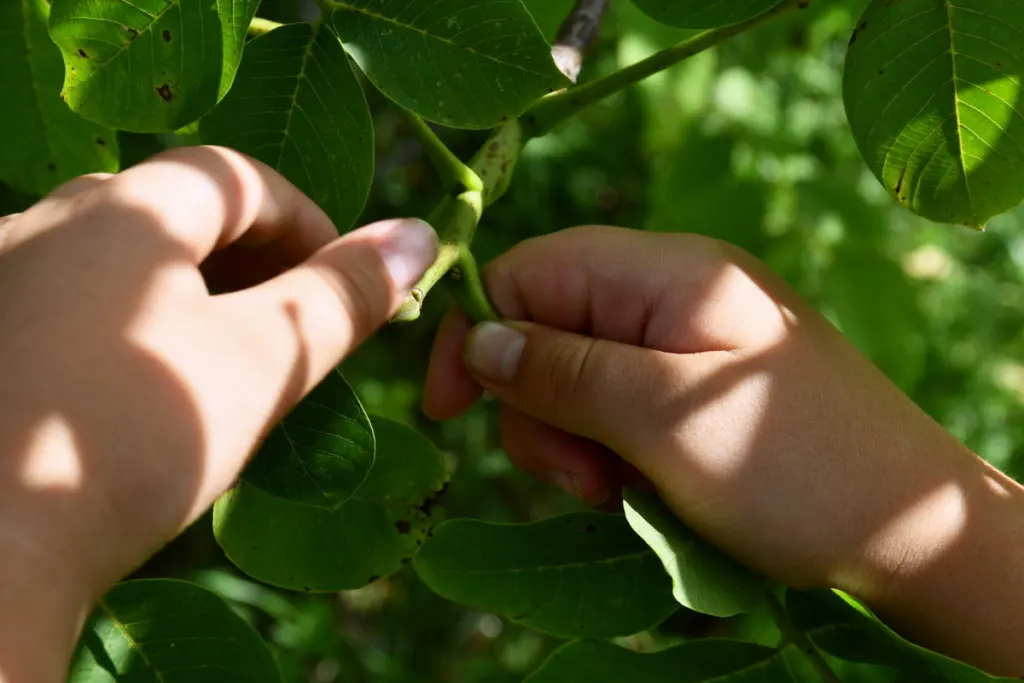
Drying walnut leaves is super easy.
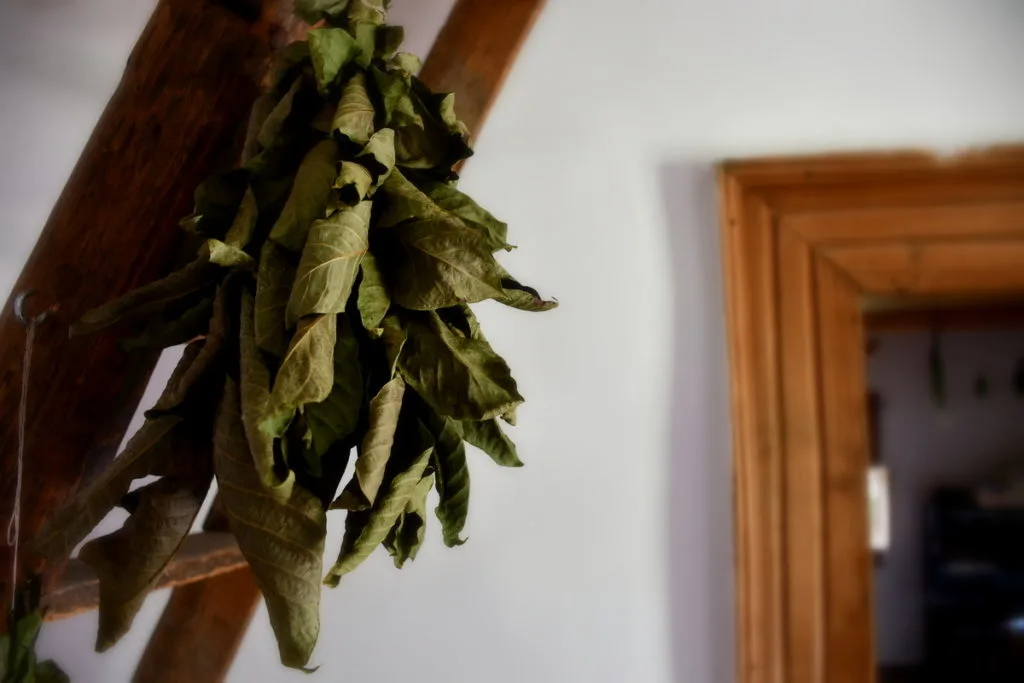
Harvest a bundle by hand, ripping them backward off the branch and tie them up to dry. Let them hang under cover for about a week until they are crispy and curled.
Then they are ready for storage.
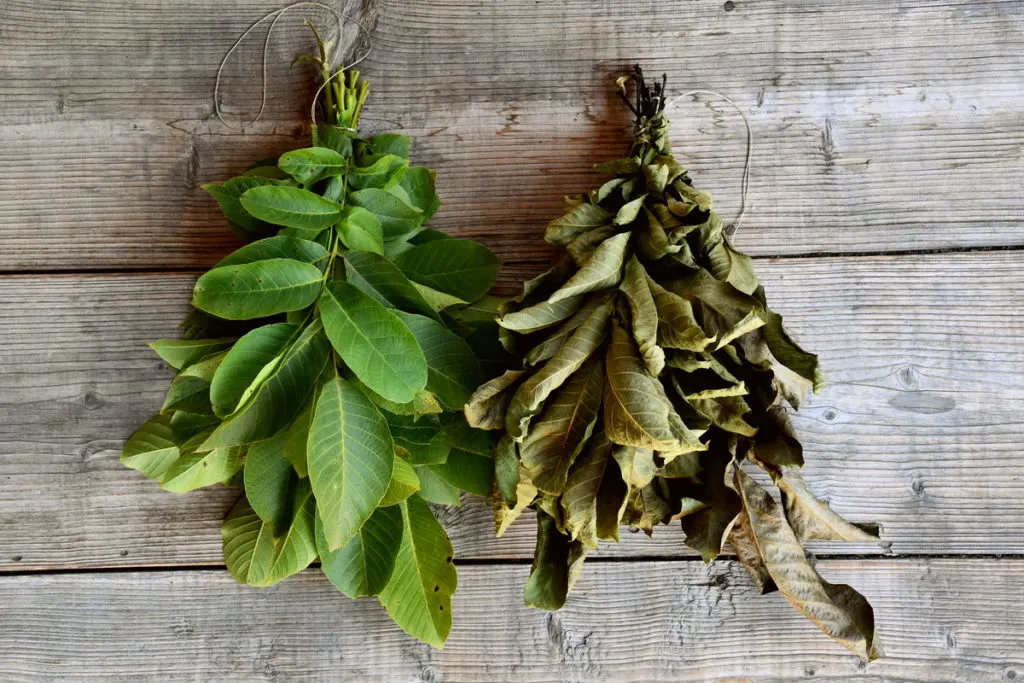
For the most part, we store our walnut leaves whole as hair rinses make up the bulk of their use. Store them in a cotton bag in your herb closet (if you have one!), or crumble up the leaves and put them in jars to save space. This works fantastic if you are using it as tea.
Since the walnut leaves are abundant every year, we harvest anew each year. This way, we always have the freshest supply.
It is always a good idea to rotate your wild foraged herbs, making sure to have enough, but not too much. With experience and time, you’ll know how much to gather for the course of a year.
Use Your Common Sense
You won’t be wanting to harvest bushels of walnut leaves, a few handfuls will be enough for your personal use. Because they are naturally astringent, you’d never want to consume more than your body needs at once.
You might choose to avoid using walnut leaves if you have a nut allergy, are nursing or are pregnant. Speak to your physician and trusted herbalist for more information.
Neither walnut hulls, nor leaves, are recommended for long-term (think everyday) use.
Most of all, have fun and don’t worry about getting your hands dirty. That’s part of enjoying nature too.

Get the famous Rural Sprout newsletter delivered to your inbox.
Including Sunday ramblings from our editor, Tracey, as well as “What’s Up Wednesday” our roundup of what’s in season and new article updates and alerts.

